BLOG - Page 37
Recently created mixtures:

Sea-Buckthorn Macerated oil
February 7, 2019

Home made air freshener
June 29, 2016

Homemade Dog-rose distillate
June 28, 2016

Homemade jasmine distillate
June 22, 2016

Moxibustion treatment with Moxa stick
May 30, 2016

Face and body gentle oil cleanser
May 26, 2016
BLOG / LATEST ADDITIONS!
Ceylon Cinnamon Essential Oil (Cinnamomum Verum) ☸ Essential oils ☸ Medicine / Health
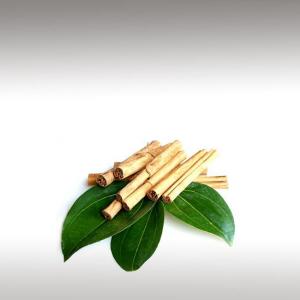
 Cinnamon is one of the most popular herbs for flavoring and medicinal uses. The herb, owing to its vast medicinal uses, has found a prominent position in traditional medicines, especially in Ayurveda. Egyptians used it for foot massage, as well as a remedy for excessive bile. It was also used as an ingredient for mulled wines, love potions and as a sedative during birth.
Cinnamon is one of the most popular herbs for flavoring and medicinal uses. The herb, owing to its vast medicinal uses, has found a prominent position in traditional medicines, especially in Ayurveda. Egyptians used it for foot massage, as well as a remedy for excessive bile. It was also used as an ingredient for mulled wines, love potions and as a sedative during birth.
Traditionally, cinnamon has been used in many cultures for treating a variety of health disorders including diarrhea, arthritis, menstrual cramps, heavy menstruation, yeast infections, colds, flu, and digestive problems.
Cinnamon is now being used all over the world for the treatment of a variety of health disorders including respiratory problems, skin infections, blood impurity, menstrual problems, and various heart disorders.
This spicy essential oil has great value in aromatherapy and it fights exhaustion and a feeling of depression and weakness. It has powerful anti-rheumatic properties, is useful in the digestive system.
findings from laboratory studies and animal-based research indicate that compounds found in cinnamon essential oil may help destroy Streptococcus mutans (a type of bacteria closely linked to the development of cavities), promote widening of the blood vessels (and, in turn, possibly aid in the treatment of high blood pressure), and control diabetes (in part by regulating blood sugar levels).
Diabetes:
Cinnamon oil has been shown to help regulate blood sugar. Add to your food, take 1-2 drops within an empty capsule, or use for self massage over the area of the pancreas. Diffusing this in the air on a regular basis is uplifting and supports the immune system. You can also use it topically, or in a bath. Depending on the type of infection you can massage the diluted cinnamon bark oil into the soles of the feet, over the area of concern, or simply diffuse throughout the area. For instance, a 2003 study published in Diabetes Care found that taking cinnamon supplements every day for 40 days reduced blood sugar and cholesterol levels in patients with type 2 diabetes.
Vaginal Infection/Vaginitis:
Diluted cinnamon oil may assist in fighting infections. Be sure to check for sensitivity and use caution. Start by massaging over the lower abdomen and groin area, avoiding contact with genitals.
Cinnamon oil may be useful as a topical treatment for infections and other skin problems, including benign tumors.
In vapor therapy, cinnamon oil can be used in acute bronchitis and colds. Cinnamon oil can be used in blended massage oil, or diluted in the bath, to assist with bronchitis, diarrhea, chills, infections, flu, rheumatism and arthritis.
Cinnamon oil has been shown to have powerful antimicrobial and cancer-fighting properties.This essential oil is quite promising as an alternative treatment for cervical cancer, colorectal cancer, melanoma and lymphoma.
The researchers suggest that cinnamon oil may be very useful as a natural treatment for inflammation.
Due to its very powerful antiseptic properties it is good for fighting any infectious diseases. It furthermore has great value in calming spasms of the digestive tract, nausea and vomiting. It stimulates secretion of digestive juices, while easing muscular and joint pains associated with rheumatism and arthritis. Care should however be taken not to irritate the skin and mucus membranes.
This essential oil is very good to use for Prevent Urinary Tract Infections.
Side effects:
Pregnant women and children should consult their primary health care providers prior to using essential oils. This oil is not suitable for children under 6 and should be diluted more for children over 6.
Submitted by OperaDreamhouse (July 8, 2014)
Ceylon Cinnamon Essential Oil (Cinnamomum Verum) ☸ Essential oils ☸ Beauty / Cosmetics

 Modern Essentials recommends using cinnamon oil aromatically (such as diffusing) or topically (diluted). Try massaging over the area of infection within a carrier oil. It's very important that you dilute this oil at least 1:3 (1 drop EO to 3 drops carrier oil).
Modern Essentials recommends using cinnamon oil aromatically (such as diffusing) or topically (diluted). Try massaging over the area of infection within a carrier oil. It's very important that you dilute this oil at least 1:3 (1 drop EO to 3 drops carrier oil).
Cinnamon Oil is a mucous membrane irritant and strong skin sensitizer. Although traditionally used for clearing warts, it is not recommended to be used in skin care products.
Submitted by OperaDreamhouse (July 8, 2014)
Ceylon Cinnamon Essential Oil (Cinnamomum Verum) ☸ Essential oils ☸ Spiritual Practises

 The Greek word 'Kinnamon' means 'tube' or 'pipe'. Cinnamon oil was used as a temple incense.
The Greek word 'Kinnamon' means 'tube' or 'pipe'. Cinnamon oil was used as a temple incense.
Emotionally and spiritually, cinnamon essential oil is related to the lower chakras and can encourage self-acceptance or self-confidence, sexual expression, and the clearing of trapped emotions from past trauma. It also correlates to our sense of safety and security, which when out of balance, can leave a person feeling jealous, insecure, controlling, or unable to be vulnerable in relationships.
The opposite of peppermint, cinnamon oil is very warming. Massage over your heart center, into the soles of the feet or around the neck for the best results.
Submitted by OperaDreamhouse (July 8, 2014)
Ceylon Cinnamon Essential Oil (Cinnamomum Verum) ☸ Essential oils ☸ Base / General

 Cinnamon oil is "Generally Recognized as Safe" by the FDA (Food and Drug Administration), and can be used in cooking. Start off with a single drop (or less, using a toothpick to grab a small amount) until you know your ratios.
Cinnamon oil is "Generally Recognized as Safe" by the FDA (Food and Drug Administration), and can be used in cooking. Start off with a single drop (or less, using a toothpick to grab a small amount) until you know your ratios.
Often the entire leaf is used as an ingredient to make herbal tea.
Submitted by OperaDreamhouse (July 8, 2014)
Thyme Essential Oil (Thymus Vulgaris) ☸ Essential oils ☸ Beauty / Cosmetics
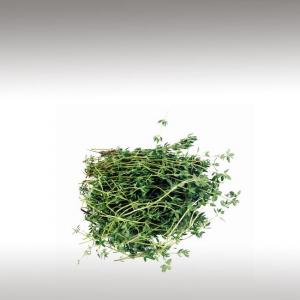

Thymus Vulgaris essential oil can cause skin irritation (easily lead to skin irritation).
But this essential oil fits for hair treatment. Thyme stimulates blood circulation. Therefore rubbing an oil that contains Thyme onto your scalp promotes the delivery of nutrients to the scalp and encourages hair growth.
Thyme is known to help with dandruff problems and to clear dirt from the scalp. Thyme essential oil is very good from hair loss.
One study by Leeds Metropolitan University found that thyme may be beneficial in treating acne.
Thymus Vulgaris essential oil have antioxidant properties and to slow down the aging process.
But this essential oil fits for hair treatment. Thyme stimulates blood circulation. Therefore rubbing an oil that contains Thyme onto your scalp promotes the delivery of nutrients to the scalp and encourages hair growth.
Thyme is known to help with dandruff problems and to clear dirt from the scalp. Thyme essential oil is very good from hair loss.
One study by Leeds Metropolitan University found that thyme may be beneficial in treating acne.
Thymus Vulgaris essential oil have antioxidant properties and to slow down the aging process.
Submitted by OperaDreamhouse (July 8, 2014)
Thyme Essential Oil (Thymus Vulgaris) ☸ Essential oils ☸ Spiritual Practises


The name is derived from the Greek word "Thymos" that means "Perfume" and was used as an incense in Greek temples. The Egyptians used it in embalming process.
The ancient Greeks used it in their baths and burnt it as incense in their temples, believing it was a source of courage.
In the European Middle Ages, the herb was placed beneath pillows to aid sleep and ward off nightmares.
In Middle Ages women would also often give knights and warriors gifts that included Thyme leaves, as it was believed to bring courage to the bearer. Thyme was also used as incense and placed on coffins during funerals, as it was supposed to ensure passage into the next life.
Thyme is used to establish a sense or a feeling of direction for the spirit. Thymus Vulgaris has great value to help with concentration and to focus.
In meditation process fits for Heart and Solar Plexus Chakras.
The ancient Greeks used it in their baths and burnt it as incense in their temples, believing it was a source of courage.
In the European Middle Ages, the herb was placed beneath pillows to aid sleep and ward off nightmares.
In Middle Ages women would also often give knights and warriors gifts that included Thyme leaves, as it was believed to bring courage to the bearer. Thyme was also used as incense and placed on coffins during funerals, as it was supposed to ensure passage into the next life.
Thyme is used to establish a sense or a feeling of direction for the spirit. Thymus Vulgaris has great value to help with concentration and to focus.
In meditation process fits for Heart and Solar Plexus Chakras.
Submitted by OperaDreamhouse (July 8, 2014)
Mandravasarotra Essential Oil (Cinnamosma Fragrans) ☸ Essential oils ☸ Base / General


Botanical Name: Cinnamosma Fragrans
Common Method of Extraction: Steam Distilled
Part Typically Used: Leaves
Color: Clear
Consistency: Thin
Perfumery Note: Top / Middle
Strength of Initial Aroma: Camphorous yet uplifting and lemony/fruity.
Native to Madagascar this evergreen and very aromatic tree can reach up to 5m of height. In Malagasy, Mandravasarotra means "What Keeps Evil Away", “That Keeps Illnesses Away”, and representing a generic term applied to plants used to neutralize spells.
Mandravasarotra is evergreen and very aromatic. It typically grows under vegetative cover in dense and dry forests.
Mandravasarotra is an uncommon oil that is also known as Saro essential oil.
This is the plant most used by the populations of the western part of the island. In that Sakalava area the plant is called Motrobeatiagnana or Motrobeatianina meaning "Big Fire in the Entrails" because its ovrground part has a spicy and hot flavour.
Common Method of Extraction: Steam Distilled
Part Typically Used: Leaves
Color: Clear
Consistency: Thin
Perfumery Note: Top / Middle
Strength of Initial Aroma: Camphorous yet uplifting and lemony/fruity.
Native to Madagascar this evergreen and very aromatic tree can reach up to 5m of height. In Malagasy, Mandravasarotra means "What Keeps Evil Away", “That Keeps Illnesses Away”, and representing a generic term applied to plants used to neutralize spells.
Mandravasarotra is evergreen and very aromatic. It typically grows under vegetative cover in dense and dry forests.
Mandravasarotra is an uncommon oil that is also known as Saro essential oil.
This is the plant most used by the populations of the western part of the island. In that Sakalava area the plant is called Motrobeatiagnana or Motrobeatianina meaning "Big Fire in the Entrails" because its ovrground part has a spicy and hot flavour.
Submitted by OperaDreamhouse (June 27, 2014)
African Wormwood Essential Oil (Artemisia Afra) ☸ Essential oils ☸ Base / General
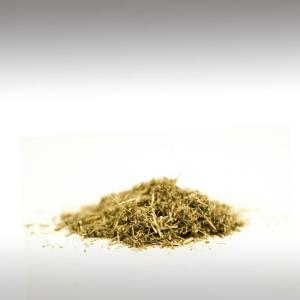

Botanical Name: Artemisia afra
Common Method of Extraction: Steam distilled
Part Typically Used: Blossom / Plant / Leaves / Stems / Roots
Color: Pale-yellow
Consistency: Thin
Perfumery Note: Top/Middle
Chemical structure: Alpha-thujone, Beta-thujone, cineole, camphor, germacrene, cadinene, alpha-terpineol, camphene, pinene, myrcene.
Artemisia afra is a small shrub native to the grasslands of Africa, ranging from South Africa to Ethiopia. Commonly growing in grasslands and open woodlands on the African continent, the shrub ranges in elevation from roughly 1450-2500m.
Artemisia afra grows in clumps, with ridged, woody stems, reaching from 0,5 meters to 2 meters in height. The leaves are dark green, of soft texture, and similar in shape to fern leaves. The undersides of the leaves are a lighter green, and are covered with white bristles.
Artemisia afra blossoms in late summer, producing abundant bracts of butter-colored flowers, each approximately 3 to 5 millimeters in diameter. Artemisia afra exudes a pungent, sweet smell when any part of the plant is bruised.
Common Method of Extraction: Steam distilled
Part Typically Used: Blossom / Plant / Leaves / Stems / Roots
Color: Pale-yellow
Consistency: Thin
Perfumery Note: Top/Middle
Chemical structure: Alpha-thujone, Beta-thujone, cineole, camphor, germacrene, cadinene, alpha-terpineol, camphene, pinene, myrcene.
Artemisia afra is a small shrub native to the grasslands of Africa, ranging from South Africa to Ethiopia. Commonly growing in grasslands and open woodlands on the African continent, the shrub ranges in elevation from roughly 1450-2500m.
Artemisia afra grows in clumps, with ridged, woody stems, reaching from 0,5 meters to 2 meters in height. The leaves are dark green, of soft texture, and similar in shape to fern leaves. The undersides of the leaves are a lighter green, and are covered with white bristles.
Artemisia afra blossoms in late summer, producing abundant bracts of butter-colored flowers, each approximately 3 to 5 millimeters in diameter. Artemisia afra exudes a pungent, sweet smell when any part of the plant is bruised.
Submitted by OperaDreamhouse (June 27, 2014)
Cape May Essential Oil (Coleonema Album) ☸ Essential oils ☸ Base / General
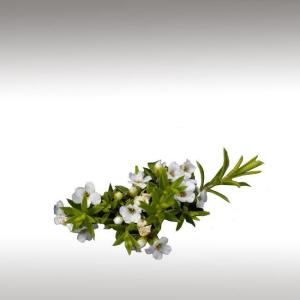

Coleonema album is a medium to large woody shrub with small
ericoid (heath-like) leaves. In spring and summer the bush is covered in
abundant small, white, star-like flowers.Resembles the European May plant.
During the flowering season the small white petals cover the ground
like confetti after a wedding, hence the colloquial name "confetti
bush". The plant is used extensively as an insect repellent, and a
deodoriser.
Botanical Name: Coleonema album
Common Method of Extraction: Steam distillation
Part Typically Used: Stem/ Leaves
Color: Clear in colour
Consistency:
Perfumery Note: Middle
Strength of Initial Aroma: Fresh herby fragrance with an interesting pepper note. Has an attractive fruity/flowery note fragrance.
Coleonema album is found in the mountain and coastal region of the Western Cape, South Africa.
Campers rub their bedding with the twigs to repel mosquitoes and ants. A wash made from the leaves is used as a deodorant, and fishermen traditionally rub their hands on the leaves to remove the fishy smell of bait. The leaves add fragrance to pot pourris.
It has been domesticated and planted in many South African gardens for its delightful show of flowers.
Submitted by OperaDreamhouse (June 27, 2014)
Muhuhu (Silver Oak) Essential Oil (Brachylaena Huillensis) ☸ Essential oils ☸ Base / General


Botanical Name: Brachylaena huillensis
Common Method of Extraction: Steam distilled
Part Typically Used: Heartwood
Color: Amber - colored
Consistency: Thick
Perfumery Note: Base
Strength of Initial Aroma: Balsamic, cool, earthy, rich, sensual, slightly musky, soft, woody.
Brachylaena Huillensis occurs from Kenya and Uganda, south to north-eastern South Africa, Madagascar and also in Angola. The wood, commonly traded as "Muhuhu" is mainly used for construction, first-grade flooring, joinery, interior trim, furniture, fence posts, toys, novelties, boxes, crates, tool handles, carving and turnery. Brachylaena Huillensis wood has been exported as short logs from Kenya to India for use as a substitute of Sandalwood (Santalum Album).
Brachylaena Huillensis is a shrub or small to medium-sized tree up to 20 (30) m tall with bole up to 45 (90) cm in diameter found in evergreen forest, deciduous bushland, secondary vegetation and dune forest in Botswana, Zimbabwe, Mozambique, South Africa and Swaziland, up to 1800 m altitud.
The aromatic oil extracted from the wood is used for perfumery. In Kenya Brachylaena Huillensis is planted as ornamental and boundary tree around dwellings. Male flowering trees are a source of pollen for honey bees.
Submitted by OperaDreamhouse (June 27, 2014)
Cape Snow Bush Essential Oil (Eriocephalus Africanus) ☸ Essential oils ☸ Base / General
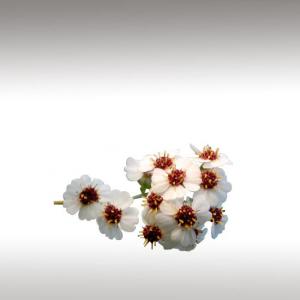

Eriocephalus africanus is a bushy shrublet indigenous to South Africa. It has a wide distribution in the Western and Eastern Cape, and in Namaqualand. The plant has several common names in various languages. It is known as the Cape Snow Bush or Kapokbossie, other common names refer to its fancied resemblance to rosemary, for example "African rosemary" or "Wild rosemary".
Botanical Name: Eriocephalus africanus
Common Method of Extraction: Steam distillation
Part Typically Used: Blossom / Plant / Stems/ Leaves
Color: Pale yellow
Consistency:
Perfumery Note: Middle
Strength of Initial Aroma: Unique combination of bitter, spicy and aromatic notes that all contribute to its unique and exciting fragrance composition.
The leaves are similar to those of Rosmarinus officinalis (Rosemary), but are greyer in colour. In spring the plant is covered in small white flowers, giving the impression that it is covered in snow – thus the name “Snowbush”. The seeds are covered with a wool-kapok.
Common Method of Extraction: Steam distillation
Part Typically Used: Blossom / Plant / Stems/ Leaves
Color: Pale yellow
Consistency:
Perfumery Note: Middle
Strength of Initial Aroma: Unique combination of bitter, spicy and aromatic notes that all contribute to its unique and exciting fragrance composition.
The leaves are similar to those of Rosmarinus officinalis (Rosemary), but are greyer in colour. In spring the plant is covered in small white flowers, giving the impression that it is covered in snow – thus the name “Snowbush”. The seeds are covered with a wool-kapok.
Submitted by OperaDreamhouse (June 27, 2014)
Fever Tea [Lemon Bush] Essential Oil (Lippia Javanica) ☸ Essential oils ☸ Base / General
![Fever Tea [Lemon Bush] Essential Oil (Lippia Javanica)](https://www.essenthouse.com/files/phthumbs/fever-tea-lemon-bush-essential-oil-lippia-javanica-0011.jpg)

Botanical Name: Lippia javanica
Common Method of Extraction: Steam distillation
Part Typically Used: Leaves, stems, roots
Color: Clear yellow to reddish
Consistency: Thin / Thick
Perfumery Note: Medium / Top
Strength of Initial Aroma: Fruity and sweet.
It is also commonly referred to as "Verbena". This 1 to 2m high woody shrub stands erect and is multi-stemmed. The stems have a square appearance when looked at in cross-section. The leaves are hairy with noticeable veins and when crushed gives off a strong lemon-like smell.
It is said to be one of the most aromatic of South Africa's indigenous shrubs. The small cream flowers can be found on the shrub from summer to autumn in some areas and in others are produced all year.
It grows in open veld, in the bush, as well as on forest margins. It can be grown from seed, but also grows easily from cuttings. It grows relatively fast and prefers sunny areas. Lemon Bush is not very particular and seems to do well in most soil types. It is known to colonise disturbed areas, making it a pioneer plant. These plants are usually very hardy and can grow under difficult circumstances, requiring little maintenance.
Submitted by OperaDreamhouse (June 27, 2014)
Katrafay Essential Oil (Cedrelopsis Grevei) ☸ Essential oils ☸ Base / General
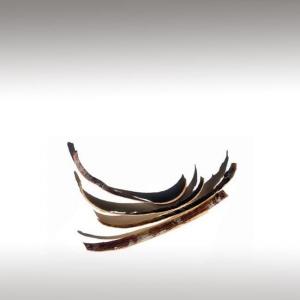

Botanical Name: Cedrelopsis grevei
Common Method of Extraction: Steam Distillation
Part Typically Used: Bark
Color: Light yellow
Consistency: Medium
Perfumery Note:
Strength of Initial Aroma: Clean scent, dry, woody, earthy, crisp and fresh and mosslike.
The Katrafay (Cedrelopsis Grevei) is a bush tree that is native to Madagascar. The tree grows to approximately 7 meters and has branches that grow pear shaped leaves with plenty of space between each leaf.
Cedrelopsis Grevei is a flowering tree that grows in dry, subhumid climates. The bark from the tree and the leaves themselves are used for the essential oil. this Katrafay essential oil is steam distilled from the bark only, and not from the leaves.
The International Federation of Aromatherapists does not recommend that essential oils be taken internally unless under the supervision of a medical doctor who is also qualified in clinical aromatherapy. Use with caution. Avoid contact with eyes and mucous membranes.
Common Method of Extraction: Steam Distillation
Part Typically Used: Bark
Color: Light yellow
Consistency: Medium
Perfumery Note:
Strength of Initial Aroma: Clean scent, dry, woody, earthy, crisp and fresh and mosslike.
The Katrafay (Cedrelopsis Grevei) is a bush tree that is native to Madagascar. The tree grows to approximately 7 meters and has branches that grow pear shaped leaves with plenty of space between each leaf.
Cedrelopsis Grevei is a flowering tree that grows in dry, subhumid climates. The bark from the tree and the leaves themselves are used for the essential oil. this Katrafay essential oil is steam distilled from the bark only, and not from the leaves.
The International Federation of Aromatherapists does not recommend that essential oils be taken internally unless under the supervision of a medical doctor who is also qualified in clinical aromatherapy. Use with caution. Avoid contact with eyes and mucous membranes.
Submitted by OperaDreamhouse (June 26, 2014)
Wheatgerm Oil (Triticum Vulgare) ☸ Base oils ☸ Base / General


Triticum Vulgare (Wheatgerm oil) is an oil expressed or extracted from the germ of Triticum Vulgare.
Triticum Vulgare contains significant amounts of Vitamin E, an essential factor in the human diet, which has led to its use as a dietary supplement.
Wheatgerm oil is a highly rich unrefined oil that is one of the richest sources of Vitamin E, A and D. It also has a high content of proteins and Lecithin. This oil is widely used for external application.
Wheatgerm oil is a very sensitive oil, therefore must be used cautiously. It tends to degrade in quality, when exposed to high temperatures. Being unrefined in nature, it is usually dark in color and also has a heavy smell. It is a good source of fatty acids that are very vital for the healthy growth of the body. The oil is taken out from the germ of the wheat.
Wheatgerm oil is known for its antioxidant properties and this explains the reason why it is added to other carrier oils. The basic idea is to enhance their shelf life and prevent rancidity.
Submitted by OperaDreamhouse (June 23, 2014)
Evening Primrose Oil (Oenothera Biennis) ☸ Base oils ☸ Base / General
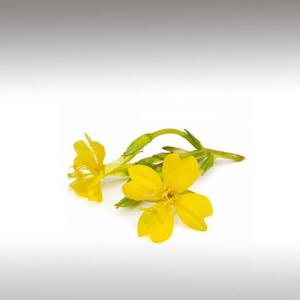

Oenothera Biennis is a species of Oenothera native to eastern and central North America, from Newfoundland west to Alberta, southeast to Florida, and southwest to Texas, and widely naturalized elsewhere in temperate and subtropical regions. Evening Primrose oil is produced from the plant.
Oenothera Biennis plant has a life span of two years. Blooming lasts from late spring to late summer. They open visibly fast every evening producing an interesting spectacle, hence the name "Evening Primrose". It is also known as Weedy Evening-Primrose, German Rampion, Hog Weed, King's Cure-All, and Fever-Plant.
The name Evening-Primrose is optionally hyphenated. Evening Primrose is not a "Primrose", a name best applied to the genus Primula. The "Evening" in the name relates to the fact that the flowers of many of the 125 species of Oenothera open in the evening and release a scent that attracts moths for pollination.
Evening Primrose, a native of North America, is found in all provinces of Canada, but is more frequent in the east than the west. The species extends south to Florida and Mexico.
Evening Primrose is a frequent weed of roadsides, waste places, and abandoned land, often found in light sandy and gravelly soils. It commonly occurs in association with early successional, biennial and perennial weeds.
The Evening or Tree Primrose is said to have originated in Mexico and Central America some 70,000 years ago. It subsequently spread right across the North American continent and from there came to Europe. It can now be found growing all over the world in temperate climates.
This oil is ritch fatty acids include omega-6 fatty acids, linolenic acid.
Oenothera Biennis plant has a life span of two years. Blooming lasts from late spring to late summer. They open visibly fast every evening producing an interesting spectacle, hence the name "Evening Primrose". It is also known as Weedy Evening-Primrose, German Rampion, Hog Weed, King's Cure-All, and Fever-Plant.
The name Evening-Primrose is optionally hyphenated. Evening Primrose is not a "Primrose", a name best applied to the genus Primula. The "Evening" in the name relates to the fact that the flowers of many of the 125 species of Oenothera open in the evening and release a scent that attracts moths for pollination.
Evening Primrose, a native of North America, is found in all provinces of Canada, but is more frequent in the east than the west. The species extends south to Florida and Mexico.
Evening Primrose is a frequent weed of roadsides, waste places, and abandoned land, often found in light sandy and gravelly soils. It commonly occurs in association with early successional, biennial and perennial weeds.
The Evening or Tree Primrose is said to have originated in Mexico and Central America some 70,000 years ago. It subsequently spread right across the North American continent and from there came to Europe. It can now be found growing all over the world in temperate climates.
This oil is ritch fatty acids include omega-6 fatty acids, linolenic acid.
Submitted by OperaDreamhouse (June 23, 2014)
Page 37 of 48

